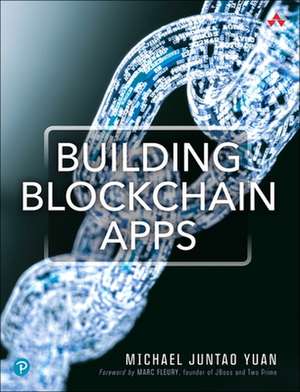Building Blockchain Apps
Autor Michael Yuan, Kwon, Jaeen Limba Engleză Paperback – 28 mai 2018
- Ethereum topics such as tools, application frameworks, internal data structure, external data interfaces, and future roadmap
- An introduction to new blockchain data protocol based on ElasticSearch, which provides insights into the current state of smart contracts and enables new application designs
- How to build an application-specific smart contract protocol by modifying and customizing the open source Ethereum Virtual Machine and its programming language tools
- How to extend and support language features that are most suitable for particular kinds of smart contracts (e.g., smart contracts for e-commerce marketplaces) with the open source Lity project
- How to customize and change the blockchain consensus layer beneath the application layer via the popular Tendermint and Cosmos SDK frameworks
- A survey of cryptocurrency and financial topics from the developers' point of view, providing an analytical framework for valuating cryptocurrencies and explaining the roles crypto exchanges
Register your book for convenient access to downloads, updates, and/or corrections as they become available. See inside book for details.
Preț: 211.41 lei
Preț vechi: 264.26 lei
-20% Nou
40.45€ • 42.35$ • 33.47£
Carte indisponibilă temporar
Specificații
ISBN-10: 0135172322
Pagini: 320
Dimensiuni: 178 x 232 x 20 mm
Greutate: 0.54 kg
Editura: Pearson Education (US)
Notă biografică
Cuprins
Foreword xvii Acknowledgments xix About the Author xxiPart I: Introduction 1 Chapter 1: An Introduction to Blockchain 3 The Blockchain 3 The Collaborative Ledger 4 Cryptocurrency 5 Smart Contracts 5 A Trustless Network 6 New Ways of Collaborating 7 The Fat Protocol 7 In Code We Trust 8 Conclusion 9 Chapter 2: Reaching Consensus 11 What Is Blockchain Consensus? 11 Proof of Work (PoW) 12 Proof of Stake (PoS) 12 Delegated Proof of Stake (DPoS) 14 Conclusion 14 Chapter 3: Your First Blockchain App 15 Smart Contract 16 Front-End HTML 19 JavaScript and web3.js 19 In Action 21 Share Your Dapp 22 Conclusion 22 Part II: An Introduction to Ethereum 23 Chapter 4: Getting Started 25 The BUIDL Way 26 The Hard Way 29 Conclusion 41 Chapter 5: Concepts and Tools 43 Ethereum Wallet and Basic Concepts 43 Etherscan 45 The TestRPC 46 Interacting with Ethereum via GETH 48 Interacting with Ethereum via web3 49 Running an Ethereum Node 50 Running a Private Ethereum Network 51 Conclusion 53 Chapter 6: Smart Contracts 55 "Hello, World!" Again 55 Learning Smart Contract Programming 57 Building and Deploying the Smart Contract 59 Calling Smart Contract Functions 65 A New Language 68 Conclusion 72 Chapter 7: Decentralized Applications (Dapps) 73 Dapp Stack 74 Dapp Showcases 76 Conclusion 79 Chapter 8: Alternatives to Dapps 81 JavaScript 81 Python and Others 85 Conclusion 86 Part III: Ethereum in Depth 87 Chapter 9: Inside Ethereum 89 What Is Blockchain State? 89 Ethereum State 92 Trie (or Tree) 93 Trie Structure in Ethereum 98 Analyzing the Ethereum Database 100 Conclusion 104 Chapter 10: Blockchain Data Services 105 Blockchain Explorers 105 Harvesting Data 109 Query Interface 115 What's Next? 119 Conclusion 120 Chapter 11: Smart Contract Search Engine 121 Introduction to the Smart Contract Search Engine 121 Getting Started with a Smart Contract Search Engine 123 The FairPlay Dapp Example 128 Use Cases 131 Conclusion 132 Chapter 12: Smart Contract Security and Best Practices 133 Major Ethereum Smart Contract Hacks and Vulnerabilities 134 Best Practices for Securing Smart Contracts 141 Conclusion 143 Chapter 13: The Future of Ethereum 145 Ethereum 1.0 146 Beyond Ethereum 1.0 150 Ethereum 2.0 152 Delivery Phases of Ethereum 2.0 154 Post-Ethereum 2.0 Innovation 155 Conclusion 155 Part IV: Building Application Protocols 157 Chapter 14: Extending the Ethereum Protocol 159 Fully Compatible, Yet Faster 160 Smart Enhancements to the EVM 160 Safety First 165 Conclusion 165 Chapter 15: Extending Ethereum Tools 167 Smart Contract Tools 168 Dapp Tools 175 Conclusion 178 Chapter 16: Example Dapps 179 Case Study 1: Valentines 179 Case Study 2: WeBet 184 Conclusion 201 Chapter 17: Business Rules and Contracts 203 An Example 204 Rules Language 206 More Business Examples 210 Conclusion 214 Chapter 18: Building an Application-Specific EVM 215 Using libENI Functions 216 Writing a libENI Function 222 Deploying the libENI Function 224 Conclusion 226 Part V: Building Your Own Blockchain 227 Chapter 19: Getting Started with Tendermint 229 How It Works 229 It Works as Follows 231 Set Up a Node 231 Set Up a Network 235 Conclusion 236 Chapter 20: The Business Logic 237 The Protocol 238 A Sample Application 240 Java Implementation 242 GO Implementation 247 The Cosmos SDK 250 Conclusion 252 Chapter 21: Creating a Blockchain Client 253 Overview of the Approach 254 The Sample Application 255 PHP 256 Java 258 Conclusion 260 Part VI: Cryptoeconomics 261 Chapter 22: The Cryptoeconomics of Token Design 263 Network Utility Tokens 263 Application Utility Tokens 266 Security Tokens 266 Token Valuation 267 Advanced Topics 271 Conclusion 274 Chapter 23: Initial Coin Offerings 275 A Brief History 275 Utility of an ICO 276 ICO vs. Traditional Equity Financing 278 Evaluating an ICO Project 280 ICO Participation Risk 282 Conclusion 283 Chapter 24: Cryptocurrency Exchanges 285 Exchange Types 285 Decentralization 287 Products and Services 288 Conclusion 289 Appendix: Getting Started with CyberMiles 291Index 295
